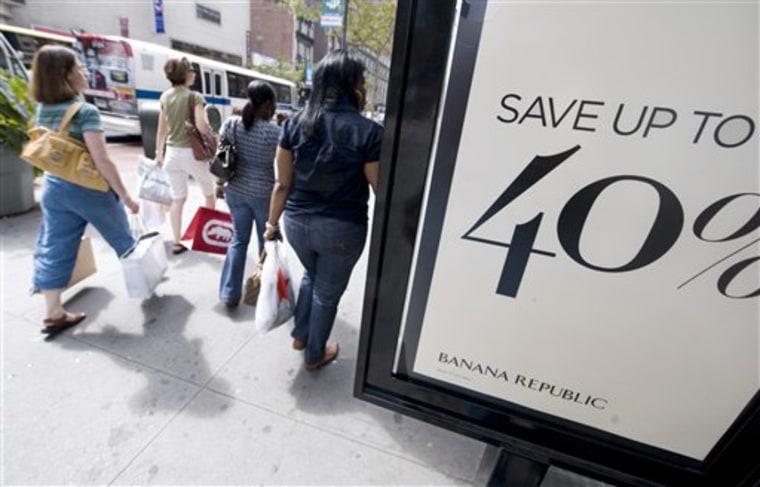In a bid to pull hesitant shoppers into their stores, retailers are slashing prices on everything from jeans to dinnerware. But those fat discounts will likely come at a big cost for the companies.
At teen retailer American Eagle Outfitters Inc., shoppers who buy jeans get a second pair at half off. Jewelry chain Zale Corp. is offering an extra 20 percent off on a slew of items like gold earrings that were already slashed up to 70 percent. And Pottery Barn has discounts of up to 75 percent.
"There's a fine line between aggressive promotions and panic, and we are seeing a little bit of both right now," said Dan Hess, founder and CEO of research firm Merchant Forecast.
While retailers entered the fall season with inventories well below last year, analysts say many were still a little too hopeful: August sales are turning out to be even weaker than expected, which analysts fear could lead to more piles of marked-down merchandise on the floor. That could in turn hurt third-quarter profits as the industry prepares for the critical holiday season. Major retailers, including Wal-Mart Stores Inc., J.C. Penney Co. and Gap Inc., which also operates Banana Republic and Old Navy stores, are slated to announce final August sales results on Thursday.
Hess estimated that discounts are 10 percent deeper at mall-based apparel stores than a year ago, despite a drop of anywhere from 10 percent to 15 percent in inventories.
"Even though retailers are entering the season conservatively, they still have been too optimistic about the consumer," he added.
Stifel Nicholas analyst Richard Jaffe noted that the weak sales trend suggests a downturn that more closely resembles the one of the mid-1970s than more recent difficult periods.
"It's a more prolonged consumer spending downturn," he said. "It's going to be tough. There's no quick way out of it."
Offering such deep discounts can cost high-end retailers such as Nordstrom Inc. and Saks Inc. in more ways than lower margins or falling profits. By doing so, analysts say, they risk hurting the cache of their brands. That's what happened to Saks, which operates luxury chain Saks Fifth Avenue, after the Sept. 11 attacks, when deep cuts on designer goods hurt the retailer's tony image.
Another major worry is that retailers could lose the power to raise prices once the economy improves. The longer stores are forced to offer generous discounts, the more used to them consumers will get, and resist buying regular-price items later on.
"I have always been price conscious," said Mike Hogan, 30, a publicist for technology companies. The Columbus, Ohio, resident admitted that he has cut back even more in recent months because of the higher daily costs of food and gas, which leave less money for extras. He expects to spend about $350 on clothes this fall, about half of what he spent a year ago, and he doesn't think he'll resume splurging even if the economy recovers — unless he received a big bump in pay.
"If it doesn't change for me, I can't understand why I would spend more," he added.
Hogan and other shoppers may have to wait a while: Many economists predict that the economy is unlikely to improve until at least well into next year. The latest batch of economic reports show consumers are still struggling to keep up with soaring living expenses. The Commerce Department reported Friday that personal incomes plunged in July, while consumer spending slowed significantly as the impact of billions of dollars in government rebate checks began to fade.
And despite a slight improvement in consumer confidence in August according to The Conference Board — helped in part by lower gas prices — the level is still near historic lows as shoppers worry about the job market and the housing slump.
The malaise is hurting all income levels, including more recently the affluent shoppers.
Saks told investors last month when it reported second-quarter earnings that it expects sales at established store to be anywhere from unchanged to down by low-single digit percentages for the second half of the year. Officials also noted that its high-end customers are now pulling back; previously, it was just aspirational customers retrenching.
But Saks is trying not to duplicate the mistake of slashing prices too much. Steve Sadove, chairman and CEO of the company, told investors last month, "I don't want us to repeat what happened five years ago or six years ago after 9/11 in terms of panicking and running. We feel very good about the assortments ... and we want to stay the course strategically."
That may be tough. Deborah Weinswig, an analyst at Citi Investment Research, noted in a recent note that she's worried that Saks' inventory levels at the end of the second quarter are high relative to recent sales trends and could hurt gross profit margins in the second half of the year.
Retailers overall are expected to report a 2 percent increase in same-stores sales for August on Thursday, with discounters like Wal-Mart and warehouse club operators such as Costco Wholesale Corp. expected to keep faring much better than the slumping apparel-based stores, according to the International Council of Shopping Centers-UBS index. Same-store sales are those at stores open at least a year, and are a key indicator of a retailer's health.
With no major fashion trend inspiring them to buy, shoppers are focusing on price and sticking to discounters even as mall-based clothing stores have been aggressively discounting. That's a big hurdle for the mall-based stores, Hess says. He noted that American Eagle's prices, with the deep discounts, are at least as good as those at Aeropostale Inc., a teen retailer that has benefited from the slow economy as it typically offers goods below American Eagle and other rivals. American Eagle's jeans, for example,are typically priced about 30 percent higher than those at Aeropostale.
Stores such as American Eagle, Hess said, are "struggling to get that value message."
